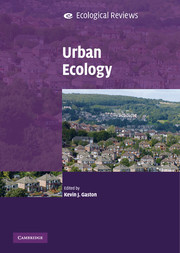Book contents
- Frontmatter
- Contents
- List of contributors
- Preface
- 1 Urban ecology
- 2 Urbanisation
- 3 Urban environments and ecosystem functions
- 4 Individual species and urbanisation
- 5 Species diversity and urbanisation: patterns, drivers and implications
- 6 Urbanisation and alien invasion
- 7 Interactions between people and nature in urban environments
- 8 Urban ecology and human social organisation
- 9 Urban ecology and human health and wellbeing
- 10 Bringing cities alive: the importance of urban green spaces for people and biodiversity
- 11 Integrating nature values in urban planning and design
- 12 Urban futures
- Index
- References
5 - Species diversity and urbanisation: patterns, drivers and implications
Published online by Cambridge University Press: 05 June 2012
- Frontmatter
- Contents
- List of contributors
- Preface
- 1 Urban ecology
- 2 Urbanisation
- 3 Urban environments and ecosystem functions
- 4 Individual species and urbanisation
- 5 Species diversity and urbanisation: patterns, drivers and implications
- 6 Urbanisation and alien invasion
- 7 Interactions between people and nature in urban environments
- 8 Urban ecology and human social organisation
- 9 Urban ecology and human health and wellbeing
- 10 Bringing cities alive: the importance of urban green spaces for people and biodiversity
- 11 Integrating nature values in urban planning and design
- 12 Urban futures
- Index
- References
Summary
Spatiotemporal patterns in species diversity have intrigued ecologists for many decades (MacArthur 1965; Brown 1981; Gaston 2000). These patterns occur at a variety of scales, for example the latitudinal gradient of increasing species richness from the poles to the Equator (Willig et al. 2003; Hillebrand 2004) and altitudinal gradients across regions (Sanders 2002; McCain 2004). Their appropriate identification and explanation have generated enormous interest and debate (Rahbek & Graves 2001; Willig et al. 2003; Field et al. 2009). It is only logical to extend this interest to urban systems and examine species richness patterns, and drivers of these patterns, across gradients of urbanisation at multiple spatial and temporal scales.
What sets urban studies apart is the implicit or explicit recognition of the major influence of human landscape modification on species distribution. Indeed, the effects of anthropogenic activity are virtually impossible to ignore in urban systems. Moreover, integrating social, cultural, economic, human demographic and ecological data, and exploring the role of human activities in moderating patterns in species diversity, are exciting developments that are forging new ground in interdisciplinary research.
In this chapter, we explore patterns in species diversity in urban systems across space and time, and briefly review some of the key drivers of these patterns and their implications. The chapter's focus is on patterns in species richness, particularly native species, as variation in species abundance and density are covered in Chapter 4. Much more attention is given to spatial patterns in richness, and this reflects the bias in the literature.
- Type
- Chapter
- Information
- Urban Ecology , pp. 88 - 119Publisher: Cambridge University PressPrint publication year: 2010
References
- 59
- Cited by



